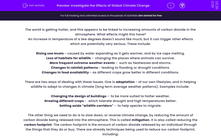The world is getting hotter, and this appears to be linked to increasing amounts of carbon dioxide in the atmosphere. What effects might this have?
An increase in temperature of a few degrees doesn't sound like much, but it can trigger other effects which are potentially very serious. These include:
Rising sea levels - caused by water expanding as it gets warmer, and by ice caps melting.
Loss of habitats for wildlife - changing the places where animals can survive.
More frequent extreme weather events - such as heatwaves and storms.
Changes in rainfall patterns - leading to flooding or drought conditions.
Changes in food availability - as different crops grow better in different conditions.
There are two ways of dealing with these issues. One is adaptation - of our own lifestyles, and in helping wildlife to adapt to changes in climate (long term average weather patterns). Examples include:
Changing the design of buildings - to be more suited to hotter weather.
Growing different crops - which tolerate drought and high temperatures better.
Setting aside "wildlife corridors" - to help species to migrate.
The other thing we need to do is to slow down, or reverse climate change, by reducing the amount of carbon dioxide being released into the atmosphere. This is called mitigation. It is also called reducing the carbon footprint. The carbon footprint is the amount of carbon dioxide released by an individual through the things that they do or buy. There are already techniques being used to reduce our carbon footprint, including:
Using energy more efficiently - for example, LED light bulbs use about one-tenth of the energy of traditional light bulbs to produce the same amount of light. They cost more to buy, but cost a lot less to use.
Using methods of generating electricity that don't produce carbon dioxide - these include renewable resources (solar, wind, tidal) and nuclear power.
Reversing deforestation - by planting more forests because trees are very effective at absorbing and storing carbon dioxide.
Capturing and storing carbon dioxide when it is produced - this is called 'carbon capture and storage'. The idea is to collect CO2 as it is produced, then pump it deep into the Earth. We know that gas (like methane) can stay underground for a long time, so this works in principle. However, this method needs more development to be used for real.
All these things are possible, and we probably need a mixture of adaptation and mitigation. Unfortunately, many of the solutions cost a lot of money, or mean that people will need to change their habits. That means it is essential that everyone understands the challenge of climate change because at the moment, not everyone is convinced. We need everyone to help to solve the problem. You might find yourself using your science knowledge to come up with new solutions!
Let's move on to some questions now.








